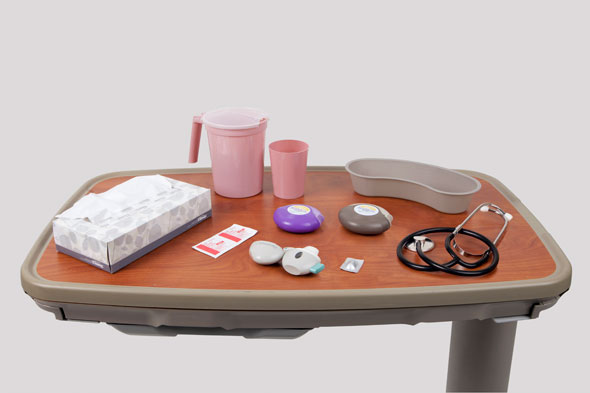Nonparenteral Medication Administration
Select a Skill:
- » Applying Topical Medications
- » Applying an Estrogen Patch and Nitroglycerin Ointment
- » Administering Eye Medications
- » Administering Ear Medications
- » Using a Metered-Dose Inhaler
- » Using a Dry Powder Inhaler
- » Inserting a Rectal Suppository
Take the Review Test:

Safety
- Ensure that the Six Rights of Medication Administration are followed: right medication, right dose, right patient, right route, right time, and right documentation.
- Be aware that medication delivered by means of a dry powder inhaler (DPI) is absorbed rapidly through the pulmonary circulation and may have systemic side effects, such as palpitations, tremors, and tachycardia.
- If the patient is receiving beta-adrenergic agonists and has a cardiac dysrhythmia characterized by lightheadedness or syncope, withhold additional doses of the medication and notify the health care provider.
- Evaluate the patient’s vital signs and respiratory status. Notify the health care provider if the patient has rapid, shallow breathing, wheezing, or paroxysmal coughing.
- Instruct any patient receiving a steroid preparation to rinse his or her mouth with warm water about 2 minutes after using the inhaler to prevent the development of a fungal infection.
- Note that DPIs vary regarding how fast the patient should inhale the medication. Consult the manufacturer’s instructions. Some patients cannot inhale fast enough to administer the entire dose of medication.
- Notify the health care provider if the patient needs to use the DPI more often than ordered.
Equipment
(Roll cursor over items to see labels)

Dry powder inhaler - Multi-dose device
Medication capsule
Dry powder inhaler - Single-dose device
Stethoscope
Alcohol swabs
Facial tissues
Cup of water
Emesis basin
Training DPI (optional)
Delegation
Medication administration by means of a dry powder inhaler cannot be delegated to nursing assistive personnel (NAP). Be sure to inform NAP of the following:
- The expected therapeutic effects of the medication and any potential side effects to report to you (e.g., anxiety, tremors, and lightheadedness)
- To report to you immediately if the patient has wheezing or paroxysmal coughing, or if the patient reports shortness of breath or difficulty breathing
Preparation
- Check the accuracy and completeness of each medication administration record (MAR) against the health care provider’s medication orders. Confirm the patient’s name, the drug and dosage, the route of administration, and the time of administration. Clarify incomplete or unclear orders with the health care provider.
- Note the patient’s allergies.
- Observe the Six Rights of Medication Administration: right medication, right dose, right patient, right route, right time, and right documentation. (For details, see the video skill “Ensuring the Six Rights of Medication Administration.”)
- Check the label on the dry powder inhaler (DPI) against the MAR two times. Note the expiration date. Prepare the DPI for administration by loading the medication. Depending on the device, you may rotate a lever or insert a capsule or disk. Follow the manufacturer’s specific instructions. DPIs vary regarding how quickly the patient should inhale the medication. Consult the manufacturer’s specific instructions.
- Do not shake the DPI, because the powdered medication may spill out.
- Use the external counter, or count the doses to determine the number of doses remaining in the device.
- Assess the patient’s respiratory pattern, and auscultate breath sounds. Obtain an oxygen saturation level if indicated.
- Assess the patient’s ability to hold, manipulate, and activate the DPI.
Follow-up
- Observe the patient’s response to the inhaled medication, noting changes in oxygen saturation level, rate of respiration, and/or breath sounds. Ask if symptoms have been relieved, and note any side effects. Assess peak flow measurement if ordered.
- Confirm the patient’s understanding of the medication’s purpose, action, possible side effects, and administration technique.
- Ensure that the patient rinses his or her mouth with warm water and spits it out after using the dry powder inhaler (DPI), to reduce the risk of throat irritation and oral fungal infection.
- Note the number of DPI doses remaining.
- Document and report side effects, the patient’s response, and/or withheld doses to the health care provider.
Documentation
- Document the inhaler medication administered, its concentration, the dose or strength, and the time of administration on the medication administration record (MAR) immediately after administration, not before.
- Document patient teaching and validation of the patient’s understanding.
- Document objective data related to the respiratory system such as respiration rate, oxygen saturation, and breath sounds; any subjective data, such as shortness of breath; and the patient’s response to the medication, including side effects like feelings of anxiety, tremors, palpitations, lightheadedness, or arrhythmia.
Review Questions
1. The nurse is preparing to help a patient use a dry powder inhaler. What will the nurse do first in order to evaluate the medication’s effectiveness?
 Assess the patient’s respiratory status.
Assess the patient’s respiratory status.  Warn the patient against overuse of the inhaler.
Warn the patient against overuse of the inhaler.  Discuss the side effects of the particular drug.
Discuss the side effects of the particular drug. Verify the patient’s identity according to agency policy.
Verify the patient’s identity according to agency policy.
2. To make sure the drug is delivered properly, what discharge instructions might the nurse give a patient who is being discharged with a dry powder inhaler (DPI)?
 Rinse your mouth out with water after using the inhaler.
Rinse your mouth out with water after using the inhaler.  Use the inhaler while sitting up in bed.
Use the inhaler while sitting up in bed.  Keep track of the dosage using the counter on the inhaler.
Keep track of the dosage using the counter on the inhaler.  After inhaling the medication, hold your breath for at least 10 seconds before exhaling.
After inhaling the medication, hold your breath for at least 10 seconds before exhaling.
3. Which statement best illustrates the nurse’s understanding of the role of nursing assistive personnel (NAP) in the use of a dry powder inhaler (DPI)?
 “Be sure to let me know if the patient starts coughing again.”
“Be sure to let me know if the patient starts coughing again.”  “Did you shake the inhaler well before giving it to the patient?”
“Did you shake the inhaler well before giving it to the patient?”  “Do you think the patient is capable of using the inhaler independently?”
“Do you think the patient is capable of using the inhaler independently?”  “Please tell the patient that the inhaler is to be used only when she is having trouble breathing.”
“Please tell the patient that the inhaler is to be used only when she is having trouble breathing.”
4. Before discharge, the nurse shows a patient how to use a dry powder inhaler (DPI). What should the nurse now assess?
 Patient’s understanding of the purpose of the medication
Patient’s understanding of the purpose of the medication  Patient’s ability to handle, manipulate, and activate the DPI
Patient’s ability to handle, manipulate, and activate the DPI  Adequacy of the patient’s planned daily medication schedule
Adequacy of the patient’s planned daily medication schedule  Patient’s awareness of the signs of an allergic reaction to the medication
Patient’s awareness of the signs of an allergic reaction to the medication
5. When instructing a patient in the use of a dry powder inhaler (DPI), which statement is accurate?
 It is important to shake the DPI before administering the medication.
It is important to shake the DPI before administering the medication. It is important to exhale while the lips are still around mouthpiece.
It is important to exhale while the lips are still around mouthpiece. It is important to read the manufacturer’s instructions to determine how quickly to inhale the medication.
It is important to read the manufacturer’s instructions to determine how quickly to inhale the medication. It is important for the patient to hold his or her breath for at least 60 seconds after inhaling the medication.
It is important for the patient to hold his or her breath for at least 60 seconds after inhaling the medication.
You have completed the Review Questions for this skill. To take the Review again select the Start Over button. To proceed to another skill select from the dropdown menu. Select the Home or Back button to proceed to the next section.


